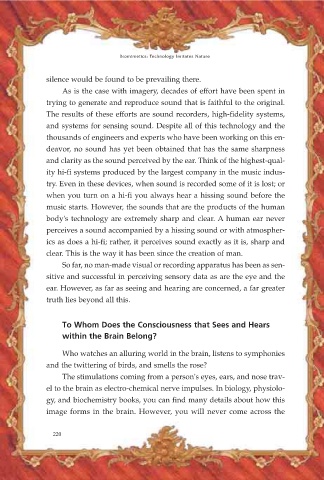Page 222 - Biomimetics: Technology Imitates Nature
P. 222
Biomimetics: Technology Imitates Nature
silence would be found to be prevailing there.
As is the case with imagery, decades of effort have been spent in
trying to generate and reproduce sound that is faithful to the original.
The results of these efforts are sound recorders, high-fidelity systems,
and systems for sensing sound. Despite all of this technology and the
thousands of engineers and experts who have been working on this en-
deavor, no sound has yet been obtained that has the same sharpness
and clarity as the sound perceived by the ear. Think of the highest-qual-
ity hi-fi systems produced by the largest company in the music indus-
try. Even in these devices, when sound is recorded some of it is lost; or
when you turn on a hi-fi you always hear a hissing sound before the
music starts. However, the sounds that are the products of the human
body's technology are extremely sharp and clear. A human ear never
perceives a sound accompanied by a hissing sound or with atmospher-
ics as does a hi-fi; rather, it perceives sound exactly as it is, sharp and
clear. This is the way it has been since the creation of man.
So far, no man-made visual or recording apparatus has been as sen-
sitive and successful in perceiving sensory data as are the eye and the
ear. However, as far as seeing and hearing are concerned, a far greater
truth lies beyond all this.
To Whom Does the Consciousness that Sees and Hears
within the Brain Belong?
Who watches an alluring world in the brain, listens to symphonies
and the twittering of birds, and smells the rose?
The stimulations coming from a person's eyes, ears, and nose trav-
el to the brain as electro-chemical nerve impulses. In biology, physiolo-
gy, and biochemistry books, you can find many details about how this
image forms in the brain. However, you will never come across the
220

